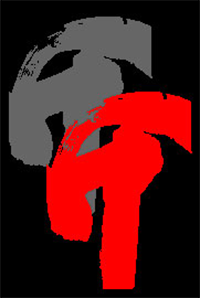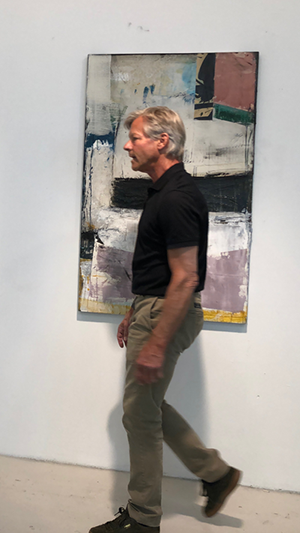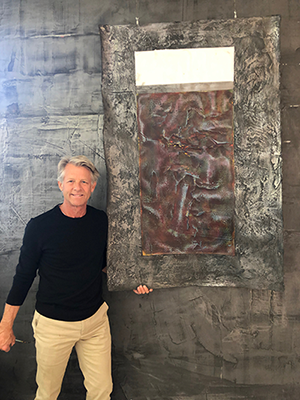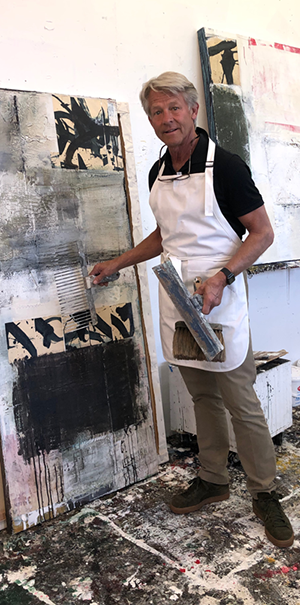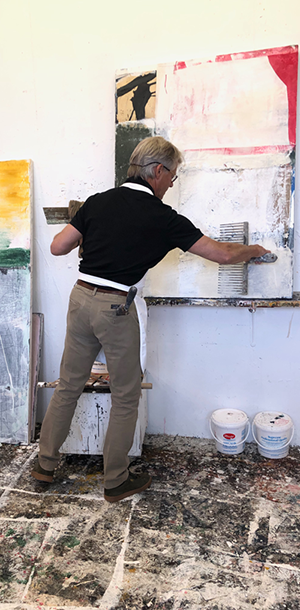Art Week, March 1992
Descended from classical abstraction and the churned, Mondrianesque panels of de Kooning, Boyer's works have a gratifying sense of object, a space that is claimed not as a window to an indefinite abstract realm but as matter-of-fact signboards in themselves. While Joshua Tree and the larger untitled pieces are surface games, the combed patches and tortured edges of Wabi and Wu have a burnished integrity and harder-nosed juxtaposition. They aim at a calculus attempted in Seshen but concisely achieved in the three small assemblages of fiberboard, graphite and concrete. These commemorate their own manufacture and bear a sturdy abstraction borrowed from industrial joints, freeway underpasses and other utilitarian forms. The textures of their rough-tolerance materials require no simulation, and provide a tangible and tactile subsidy for the efforts of a painter mentored by the self-assured sculptor within.
- Casey FitzSimmons
Coast Weekly, August 2001
Possibly the only thing that makes Peter Boyer happier than putting paint on canvas is taking it off--with a trowel, with his hands, with one satisfying rip exposing splintered plywood.
"It's very physical," he says when asked about his creative process. "The painting starts out very noisy. I put material on, take it back off. Toward the end things start to quiet down and it gets a little more contemplative. That's what I'm really looking for--contemplation."
In spite of its athletic origins, the San Francisco painter's work, now on exhibit at the spare glass-and-granite Sierra Mar Restaurant in the Post Ranch Inn, reveals a distinctly Asian aesthetic of serenity. Although the geometric shapes suggest cerebral precision, their borders are in fact blurred; certainty plays with ambiguity to soothing effect.
Boyer hastens to note that such literal plots don't play a role in his process. "I try to stay away from specifically illustrating Zen ideas," he says. "I want the paintings to be these objects of contemplation through this wrestling process that I go through with them."
It seems to work. I found that after I first viewed Boyer's paintings, I was left with an impression of calm that was somewhat ruffled when I returned for a second look--some of the textured surfaces, especially in Kobe and Shibui 31 behaved like mild irritants to the eye, more frenetic than I had remembered. Once again, however, tranquility returned after I'd left the exhibit--perhaps because of the memory of the larger color blocks, which consisted of thick applications of paint in cool tones.
In Shibui 31, vast, chalky fields of white expand over the canvas, where it's brightened, dulled, textured--anything but left to sit there in a single dimension. The blocks of color, sometimes pulsating with intensity, sometimes washy, interrupt the surface.
In one of the show's recurring motifs, snippets of what appears to be some sort of Asian calligraphy, rendered with a fat blank ink-painting brush, accent the canvases. These accents, or "gesture marks," as Boyer calls them, are not actually characters at all, but random marks on high-quality paper that Boyer lays over the floor, paints, then cuts up. They serve as points of entry to the pieces--glimpses of the almost familiar.
It's hard to exaggerate the pleasure of a trip to Sierra Mar. Its vertiginous placement on a steep hillside, its floor-to-ceiling windows--it feels like you're hanging above the Pacific in mid-air when you sit down to dine--combine to give the sense that you've already left the Western hemisphere and are on your way to the other side of the Pacific Rim. Boyer's Asian vision complements the sensation perfectly.
- Traci Hukill
Monterey County Herald, August 2001
The most recent work to occupy Sierra Mar's walls is by San Francisco artist Peter Boyer. His showcase, titled "moving out of abstraction," consists of pieces that focus on texture and often have an Asian look about them--an aspect, Boyer says, that is unintentional.
"It was pointed out to me that my work has this Japanese feel," said Boyer in a telephone interview. "It was afterward that I discovered more about Japanese form."
Several of his pieces are called "Shibui," a Japanese term which, according to Boyer, means "aesthetic restraint--a way of describing something that's understated."
The Sierra Mar is the most recent of Boyer's numerous venues, which have included shows nationwide, reaching as far as Boyer's native New York.
Eric-Paul Leyva, founder of Goya and Ray, noticed Boyer's work at the Monterey Museum of Art's "Art of the Millennium" show. "His work just kind of stuck out," said Leyva.
When viewing Boyer's work, "stuck out becomes a literal statement.
"What I don't do is stretch canvas and apply paint to it," Boyer points out. The tactile aspect is one of his work's main features. Using a variety of materials, such as paint, charcoal and graphite, Boyer forms his art "in a haphazard manner."
For a typical piece, he piles layer upon layer of material on the canvas, varying the thickness throughout the piece. When he feels an area has been overdone, he puts a scrap of canvas over the area and continues to work, either applying over the area or tearing the scrap off and rubbing it with sandpaper or graphite.
Influenced by a stint at the Southern California Institute of Architecture in Los Angeles, Boyer often uses tile tools and combinations of acrylic mediums and marble dust, creating something "similar to a plastered or fresco wall." This gives many works the grooved look of a floor about to be tiled.
A piece is complete, he says, "when it carries what I call a presence."
Rather than attach complex, specific meaning to his art or make social statements, Boyer seeks to make each piece an "object of contemplation."
He likens the process to meditation: "Painting is always very noisy at first. I work on it until it gets quiet."
- Allison Charmichael
